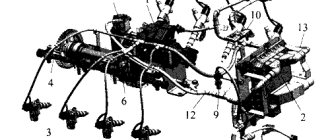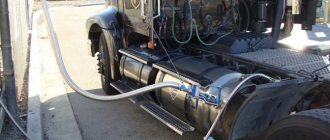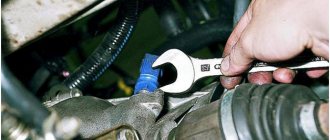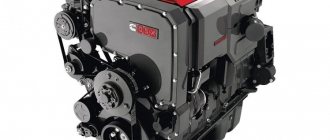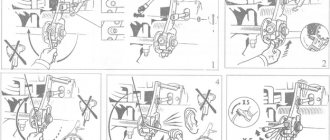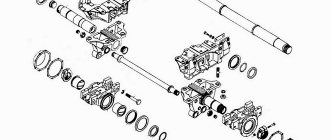Category: KAMAZ
- The role of lubrication in the engine
- KamAZ oil pressure sensor
- Purpose of the sensor
- Where is the pressure sensor located on KamAZ?
- Standard electrical sensor
- Operating principle of the measuring device
- Troubleshooting
- Replacing the control device
Few owners were interested in where the oil pressure sensor is on KamAZ, but at the same time, this simple device speaks volumes. The stability and long-term operation of the power plant is directly related to the lubrication of components and parts. The pressure of the lubricating fluid in the engine channels gives a complete picture of the processes taking place inside the unit.
A sensor installed next to the engine frame provides information about the oil pressure level on a KamAZ vehicle. The information received is transmitted to the driver’s dashboard, analyzed and, if the norm is violated, helps to make an adequate decision on a set of further measures. In order to prevent failure of the power plant, every KamAZ driver is required to have the knowledge to check the functionality of the sensor or replace the control device.
KamAZ-43114:
The role of lubrication in the engine
Before considering the device and types of sensors, let’s figure out whether lubrication in the engine is so important. When calculating the power plant, designers make the surfaces of components and mechanisms as strong as possible. This helps to increase the life of the unit and the quality of its functions. Since the products are in contact with each other, the frictional force that arises between them leads to wear on the mechanisms. Lubricating parts is the only way to combat friction.
Oil circulation through channels under pressure is a condition for performing the assigned functions. A way to check the correctness of the indicators is an oil pressure sensor, similar to the device installed on the KamAZ 740.
Engine KamAZ-740:
Maintaining the performance and functionality of the motor, the lubricant does:
- Coating the surfaces of parts with an even layer of oil;
- Removal of some heat;
- Removing dirt and abrasive particles;
- Anti-oxidation;
- Strengthening the connection and connection of parts;
- Acting as a working body.
It is taken into account that the pressure value is controlled in an installation heated to a temperature of 70°C. Normal KamAZ engine speed is 2600 min-1. The standard pressure value is 0.45-0.5 MPa.
Design and principle of operation of the crankshaft sensor
In order for the sensor to transmit a signal through a wire to the ECU microcontroller, the following principle is used:
- two flywheel teeth were deliberately omitted;
- when entire flywheel teeth rotate near the DPKV, they distort the magnetic field arising in the device coil;
- when a section of the crown with a missing tooth passes near the sensor, the interference disappears;
- the device transmits a signal about this to the computer, and the computer determines the exact position of the pistons in each cylinder.
DPKV design
Correct operation is possible only with a gap of 1 - 1.5 mm between the teeth of the flywheel ring and the electrode of the device. Therefore, there are adjusting washers above the DPKV mounting socket. And the 0.5 - 0.7 m long wire suitable from the ECU is equipped with a turnkey connector.
The ECU software allows you to calculate the position of the pistons in cylinders I and IV when a signal is received and the direction of shaft rotation. This is enough to correctly generate signals to the fuel supply and ignition sensor.
Optic
Structurally, this sensor is made of an LED and a receiver. The signal appears in the receiver when it passes through a section of the flywheel with ground teeth, since at this moment the LED beam is not blocked by the remaining intact teeth.
Optical DPKV
These simple steps do not allow you to use the device for any additional operations. If a breakdown occurs (ignition desynchronization), the DPKV is replaced along with the wire.
Hall Sensor
Working on the principle of potential difference in the cross section of metals (Hall effect), the crankshaft position sensor has the additional function of distributing ignition into the combustion chambers of the cylinders.
Hall Sensor
A fairly simple operating principle of the sensor is based on the generation of voltage due to a change in the magnetic field. Without a flywheel with two ground teeth, this device will not work.
Inductive
Unlike previous modifications, the magnetic crankshaft position sensor operates on the basis of electromagnetic induction:
- a field is constantly generated around the device;
- voltage for the signal to the microprocessor occurs only when passing through a section of the flywheel rim with missing teeth.
Shaft position monitoring is not the only option of this device; in addition, it serves as a shaft speed sensor.
Magnetic DPKV
Since the magnetic device and Hall sensor are multifunctional devices, they are most often used in engines.
Purpose of the sensor
The oil system is a mandatory attribute of an internal combustion engine. In order for the liquid to perform its assigned functions, the required level of the substance, operating pressure and quality are maintained. The level is monitored by a control probe, the required quality is maintained using a filter element, but the sensor is responsible for the lubricant pressure. A similar device, the KamAZ Euro 4 fuel pressure sensor controls the pressure of diesel fuel. The difference is in the chemical composition of liquids and the location of devices. The fuel meter is installed on the ramp, the oil meter is installed on the engine.
There are two types of pressure sensors:
- Mechanical sensor;
- Electrical sensor.
Electrical Oil Pressure Sensor (Cummins):
An electrical sensor monitors critical pressure deviations from the norm. In the event of danger, an electrical sensor signals a problem by lighting a light on the instrument panel. The mechanical device digitally displays the pressure level.
Since the mechanical indicators are more accurate, owners prefer to install them on the engine instead of a standard electrical device. Thus, the electronic sensor on the KamAZ 740.30-260 engine is often replaced with a mechanical device. The advantage of this replacement is that the cost of the part is not high, you can buy the device anywhere, and the readings taken provide more information. You can also read about KamAZ Management.
Where is the pressure sensor located on KamAZ?
The design of the measuring device is simple:
- Casing made of steel;
- Elastic membrane;
- Stock;
- Contacts.
KamAZ lubricant pressure sensor:
Regardless of what type of meter KamAZ uses, the mounting of the products is standard. As a rule, the oil pressure sensor is installed on a KamAZ truck on the frame of the power unit, on the bracket where the oil filter element is located.
DPKV location
Even with a dense arrangement of components and assemblies of the car under the hood, manufacturers try to ensure the availability of DPKV for quick replacement on the road. Therefore, understanding where the crankshaft sensor is located is quite simple:
- it is located between the generator pulley and the flywheel;
- the wire is long enough to easily connect it to the on-board network;
- There are adjusting shims on the seat to set the gap to 1 - 1.5 mm.
Crankshaft sensor location
Thanks to the turnkey head, even a novice driver can remove the sensor.
Operating principle of the measuring device
The difference between electrical and mechanical sensors lies in the operating principle. Structurally, the electronic oil pressure sensor installed on KamAZ Euro 2 and other vehicles is simpler than its mechanical counterpart. The purpose of use is to promptly inform the user about the danger associated with a drop in pressure. Composition of an electronic device: casing, membrane, rod, contacts. There is also a lamp located on the dashboard.
If the liquid pressure corresponds to a predetermined level, the plate inside the sensor is compressed. The deformation of the plate causes the rod that opens the contacts to move. An open circuit in the car prevents the indicator on the dashboard from lighting up.
The low pressure of the liquid is not enough for the membrane to move the rod, the pusher does not move. In this case, the circuit is constantly closed, the indicator lights up, warning the driver about problems in the power plant. Further operation of the engine is fraught with serious damage, so the driver must identify problems as soon as possible. Such products are installed on KamAZ 740.31-240 engines that comply with the Euro-2 standard, etc.
Diagram of an electronic lubricant pressure measuring device:
The mechanical device is structurally different. So, in addition to the body, pusher and membrane, the device is equipped with a winding made of nichrome, a slider and other, less important parts. The principle of operation is to move the slider pusher rod along a nichrome panel. The scale with numbers provides information about where the slider is currently located. The membrane moves the pusher by changing the pressure, the rod is rigidly connected to the resistance. The information is reflected on the arrow-type instrument panel indicator.
Diagram of a lubricant pressure measuring device (mechanics):
These types of sensors provide more information than electronic devices, which is why their popularity is growing. These mechanisms are equipped with KamAZ 740.63-400 engines that comply with Euro-3, Euro-4 standards.
Coolant temperature sensor KAMAZ 5320 markings
Instrumentation provides monitoring of the operation of vehicle and engine systems and includes indicators and sensors. All indicators are installed on the instrument panel in the driver's cabin. The sensors are installed on the chassis and engine units.
Technical specifications
12.3802, magnetic induction, with electric drive
AP 170, magnetoelectric
MM 370, membrane type with rheostat
BM 158-B, lever type with rheostat and warning device for fuel consumption warning lamp
An electric speedometer consists of a transducer (sensor) that supplies signals to the receiver; a receiver (a three-phase synchronous motor excited by permanent magnets) and a magnetoinductive speedometer mechanism with a counting device.
The receiver is structurally combined with a magnetoinductive mechanism into one speedometer indicator device. The design of the speedometer is shown in Fig. 350. Schematic diagrams of the speedometer and tachometer are shown in Fig. 351, 352.
Rice. 350. Speedometer indicator: 1 — plug block; 2 - printed circuit board with semiconductor elements; 3 — pointer body; 4 - counting device; 5 — magnetic induction mechanism; 6 — signal lamp socket; 7 - electric motor
Rice. 351. Schematic diagram of the speedometer
Rice. 352. Circuit diagram of an electronic tachometer: I - to the control instrument lighting switch; II, IV - to the car body; III - to the generator phase; C1, C2, SZ, C4 - capacitors; R1. R13 - resistors; VI, V8 - zener diodes; V2, V5, V7 - transistors; V3, V4, V6 - diodes; E1 - lamp A24-1
Maintenance
During daily maintenance, before leaving the park, check the operation of the speedometer and tachometer using the indicator arrow and trip meter.
During service 2, check the condition and reliability of the axle lock and brake light sensors.
To perform a control check of the speedometer and tachometer, it is necessary to have an installation with which you can obtain various fixed values of the rotation speed on the shafts of the products being tested and the control.
When checking sensors, connect the speedometer control receiver alternately with the sensor being tested and the control sensor. By comparing the two readings obtained, estimate the error of the device being tested.
When checking the speedometer receiver, it is necessary to have a test sensor. You can also check using the comparison method.
Connect power to the tested and control products from a power source in accordance with the connection diagram on the vehicle.
The simplest installation on which such a check can be carried out is KTU1.
When checking the technical condition of an ammeter, evaluate the accuracy of its readings by comparing it with the readings of a control ammeter, which, together with a rheostat to regulate the current, are connected in series with the device being tested. Test in forward and reverse current directions at current values of 10, 20 and 30 A.
The permissible error of the ammeter is 7% of the sum of the final scale values at ambient temperature (20±5)°C.
Check the pressure indicators in the engine lubrication system together with the sensor by comparing them with the readings of the control pressure gauge, installing them in a reservoir with adjustable pressure and connecting the power in the same way as the switching circuit on a car.
Permissible pointer error ±7%; from the upper limit of measurement in the operating pressure range 0. 686.5 kPa (0. 7 kgf/cm 2 ) and ±10% - in the pressure range above 686.5 kPa (7 kgf/cm 2 ) (at ambient temperature (20 ±5)°С.
When checking the pointer using a rheostat, the readings must correspond to the data in the table. 56.
TABLE 56
Data for checking the oil pressure gauge
| Controlled scale marks | Rheostat resistance |
| 0 | 165 |
| 2 | 132 |
| 4 | 98 |
| 6 | 70 |
| 8 | 42 |
| 10 | 20 |
The easiest way to check the fuel level indicator and sensor for accuracy is to gradually fill the tank with fuel using a measuring vessel and compare the readings of the device with the actual amount of fuel in the tank. The permissible error of the pointer together with the sensor is 7% of the tank capacity at ambient temperature (20±5)°C. If the error exceeds the permissible limit, determine which device is faulty by replacing the sensor or pointer. If the measurement error exceeds the permissible value and is directed in the same direction at all tested levels, adjust the sensor, if possible, by bending the float lever.
To check the accuracy of the readings of a pointer with a rheostat connected in series, instead of a sensor, use the resistance values indicated in the table. 57.
TABLE 57
Data for checking the fuel level indicator
| Verified marks | Rheostat resistance values |
| 0 | 0. 8 |
| 1/2 | 36,5. 43,5 |
| P | 78. 95 |
Check the coolant temperature gauge and sensor by comparing it with the readings of a mercury thermometer. Place the sensor together with the thermometer in a tank of water, the temperature of which is gradually increased. Connect the pointer to the sensor in accordance with the connection diagram, connect the sensor body to the negative terminal of the battery. Evaluate the accuracy of the device being tested.
The resistance values of the rheostat included in the circuit instead of the sensor must correspond to the values indicated in the table. 58, at certain pointer readings. Permissible error of readings: ±8°С at a water temperature of 40°С and ±5°С at a water temperature of 80–100°С.
TABLE 58
Data for checking the coolant temperature gauge
| Scale marks | Resistance |
| 40 | 360. 560 |
| 80 | 134. 150 |
| 100 | 83. 92 |
Checking of control and measuring instruments is also carried out on a control installation of type E204 and similar.
To check for an open circuit in the pointer-sensor circuit, disconnect the wire from the sensor and connect it in series with a 2 W light bulb to ground the car. If the wire is broken, the position of the arrow will not change and the light will not light. If the wire is not broken, the pointer arrow will deviate and the light will light up.
To check the short to ground of the wire connecting the sensor and the pointer, disconnect the wire from the sensor with the power on, and if the arrow does not change its position, then the wire is shorted to ground, otherwise disconnect the wire from terminal D of the pointer, then in this case the arrow will deviate .
TABLE 59
POSSIBLE MALFUNCTIONS OF CONTROL AND MEASURING DEVICES AND METHODS OF THEIR ELIMINATION
The coolant temperature gauge 14.3807 is electromagnetic, ratiometric type. Designed to monitor the temperature of the coolant in the engine. Equipped with an overheat alarm. On UAZ cars it is part of the instrument panel 14.3805 or KP116-3805010. Works in conjunction with the TM100 temperature sensor.
Coolant temperature gauge 14.3807, characteristics.
The coolant temperature gauge 14.3807 is an electromagnetic ratiometer with fixed coils and a moving permanent magnet connected to a pointer. In addition to vehicles of the UAZ-31512 family, UAZ-3741 and UAZ-3909 vans, UAZ-3962 ambulances, UAZ-2206 buses, UAZ-3303 and UAZ-39091 trucks, the coolant temperature indicator 14.3807 is used on GAZ, ZIL, URAL, LUAZ vehicles , and buses PAZ, ERAZ, KAVZ.
Main characteristics of the pointer 14.3807:
Coolant temperature sensor TM100, characteristics.
Pointer 14.3807 receives readings from the TM100 temperature sensor, which is installed in the engine cylinder head. The working element of the sensor is a thermistor placed in a metal case.
Main characteristics of the TM100 temperature sensor:
Connection diagram for temperature indicator 14.3807 and temperature sensor TM100.
Warning lamp for the maximum temperature of the coolant in the radiator and temperature sensors TM104 or TM111-09.
The warning lamp is located on the UAZ instrument panel and works in conjunction with the temperature sensor TM104 or TM111-09, which is located in the upper part of the radiator. The bimetallic plate inside the sensor closes the contacts and the warning lamp lights up when the coolant temperature in the radiator is between 91-98 degrees.
During operation of the vehicle, a significant decrease in the level of coolant in the engine cooling system and, as a result, exposure of the tubes in the upper radiator tank is not allowed, since overheating may cause the temperature sensor to fail.
Reversing the TM100 sensor of the coolant temperature indicator and the TM104 or TM111-09 sensor of the warning lamp for emergency overheating of the coolant is not allowed, since the indicator and lamp will not work in this case.
Diagram of connection and operation of the emergency temperature sensor TM104 or TM111-09.
Location of temperature sensors TM100 and TM104 in vehicles of the UAZ-31512 family.
Location of temperature sensors TM100 and TM111-09 in vehicles of the UAZ-3741 family.
Checking the serviceability of temperature indicator 14.3807 and temperature sensor TM100.
The coolant temperature gauge 14.3807 is checked by comparing its readings with those of a thermometer. To do this, you need to unscrew the TM100 temperature sensor, lengthen its wire if necessary, connect the sensor with a separate wire to the ground of the car and place it together with the thermometer in the middle of a vessel with water heated to a boil. The sensor terminal should not be immersed in water.
Then it remains to compare the readings of the temperature indicator 14.3807 and the thermometer. The water temperature is brought to the required value by adding cold water to the vessel. At water temperatures of 100 and 80 degrees, the error in the indicator readings should not exceed +-5 degrees, and at a water temperature of 40 degrees, the error should not exceed +4 or -12 degrees.
If the indicator readings exceed the specified limits, then you must first try to replace the TM100 sensor, and if this does not give positive results, then replace the coolant temperature indicator 14.3807.
If the pointer arrow is constantly at the beginning of the scale.
Then, with the ignition on, disconnect the wire from the pointer sensor and connect its tip to ground. If the arrow deviates, then the sensor is faulty and must be replaced. If the arrow does not deviate, remove the instrument panel and, with the ignition on, connect terminal “D” of the indicator to ground. The deviation of the arrow in this case will indicate its serviceability and damage to the wire connecting the sensor to the pointer. If the arrow does not deviate, then the pointer itself is faulty.
If the pointer needle is constantly at the end of the scale.
Then, with the ignition on, disconnect the wire from the sensor. If the sensor is faulty, the needle should return to the beginning of the scale. If the arrow remains at the end of the scale, then the wire has a short to ground or the pointer is faulty. Its serviceability can be checked by disconnecting the wire from terminal “D”. When the ignition is on, the needle should be at the beginning of the scale.
Checking the temperature indicator 14.3807 using a control rheostat.
To check the 14.3807 pointer in this way, it must be connected to a control rheostat. With a resistance of the control rheostat of 400-530 Ohms, the needle should be near the 40 degree mark. With a resistance of 80-95 Ohms - about the 80 degree mark. With a resistance of 51-63 Ohms - about 120 degrees.
Diagnostics of the serviceability of the TM100 temperature sensor by its resistance.
Repair of the coolant temperature indicator and its sensor.
Coolant temperature gauge 14.3807 and sensors TM100, TM104 and TM111-09 cannot be repaired. Therefore, if they malfunction, you should only check the electrical connections and wiring, and if they are in order, then replace the pointer or sensors with new ones. It is recommended that you try replacing the sensors first, as they tend to fail more often.
Attention: The electronic auto parts catalog is intended for reference purposes! Our company only sells those products that have prices listed.
| Number | 5320-3828030 |
| Name | Coolant temperature warning sensor assembly |
| Quantity per "" | 1 |
| Model | 5320 |
| Group | Devices |
| Subgroup | Coolant temperature gauge sensor |
| Part serial number | 030 |
Part number on drawing:
Coolant temperature warning sensor assembly
Serial number: 5320-3828030 Quantity per model: 1
| Number | 5320-3828010 |
| Name | Coolant temperature gauge sensor |
| Quantity per "" | 1 |
| Model | 5320 |
| Group | Devices |
| Subgroup | Coolant temperature gauge sensor |
| Part serial number | 010 |
Part number on drawing:
Coolant temperature gauge sensor
Serial number: 5320-3828010 Quantity per model: 1
We are open to cooperation and accept orders for any volume of products.
Full or partial use of any materials or their copying is permitted only with the written consent of the site administration.
This page will provide reviews of the spare part: Water temperature indicator UK171 (5320-3828010). If you have any questions, leave your feedback, we will definitely answer you!
You can pay for the spare part: Water temperature indicator UK171 (5320-3828010) using the following options:
- Non-cash with and without VAT. It is optimal for legal entities. After the necessary approvals, our manager will prepare payment documents and you just need to transfer the money to your current account.
- Cash: Payment is made directly at the time of placing the order (only in the city of Naberezhnye Chelny).
- Payment by bank card (MIR, VISA International, Mastercard Worldwide) for pickup at the address Naberezhnye Chelny, Menzelinsky tract 36/2 and Naberezhnye Chelny, Kazansky pr., 224, (PGO "Garage-2000", 5/1)
Delivery of spare parts
Automotors cooperates with all transport companies. You can specify the Transport company for delivery of the ordered cargo when filling out an application on the company’s website, or when communicating with the AutoMotors manager
Delivery across Russia
carries out delivery throughout Russia, including to the cities: Moscow, Novosibirsk, St. Petersburg, Nizhny Novgorod, Yekaterinburg, Kazan, Khabarovsk, Omsk, etc. Delivery to the transport company is free of charge
Delivery to EAEU countries
We supply goods to the countries of the EAEU (Belarus, Kazakhstan, Armenia, Kyrgyzstan)
with VAT 0%.
Pickup
If it is more convenient for you to pick up the order yourself, you can do this by driving to the warehouse. The manager will inform you about the availability of a completed order.
Warranty for spare part: Water temperature indicator UK171 (5320-3828010)
- Product quality – we work only with reliable suppliers;
- Reliability of purchase - we work in full compliance with the law “On the Protection of Consumer Rights”;
- Manufacturer's original warranty - we maintain the manufacturer's original warranty for service at authorized service centers for all products for which it is provided.
- High quality of service and reliability of purchase - our store was created for the convenience of customers;
- Minimum prices for a maximum of goods - we carry out direct wholesale purchases from manufacturers;
- Possibility of placing an order without registration - you simply select the product you like on the website and fill out the necessary fields for delivery of the order.
carries out delivery throughout Russia, including to the cities: Moscow, Novosibirsk, St. Petersburg, Nizhny Novgorod, Yekaterinburg, Kazan, Khabarovsk, Omsk, etc. We supply goods to the countries of the EAEU (Belarus, Kazakhstan, Armenia, Kyrgyzstan)
with VAT 0%.
How payment and delivery of spare parts works and which transport companies we work with can be read on this page.
The system of control and measuring instruments (instrumentation) is designed to monitor the operating modes of units and individual assembly units of the vehicle, as well as determine the speed of movement.
Rice. 7-32. Instrumentation system
The main elements of the instrumentation system are (Fig. 7-32):
- speedometer indicator 1211.3802 P2 - magnetic induction, with electric drive; -speedometer sensor ME307 B3 - sealed, magnetoelectric, generates a variable frequency current;
— tachometer indicator 363.3813 P1 — electronic;
— instrument cluster 281.3801 P4;
- oil pressure indicator sensor MM370 B8 - membrane type with rheostat;
— emergency oil pressure sensor MM111-D V9;
- temperature indicator sensor TM100-A B10 - semiconductor, with a thermistor; -temperature alarm sensor TM-111 B11 - thermobimetallic;
- two fuel level indicator sensors SYAMI 407611-114 (B2, B14) - lever type with a rheostat and a warning device for the fuel consumption warning lamp;
— fuel level indicator switch P147 S26;
- 8 A fuse in block F3 type PR112.
Also working together with the instrumentation system are: generator G1, sound relay-signaling H2, diodes with protective housing V1, V6.
All indicators and instrument cluster are installed on the instrument panel in the driver's cabin. The sensors are installed on the chassis and engine units.
The instrument cluster, speedometer and tachometer are connected to the car body by separate wires.
All instrumentation is connected in parallel through the instrument and starter switch and is protected by an 8 A fuse.
Connection to the on-board network and joint operation of sensors and indicators of the instrumentation system of KAMAZ vehicles can be seen from Fig. 7-32. Therefore, below we will dwell in more detail on the device and principle of operation of sensors and indicators.
The speedometer is designed to inform the driver about the speed of the vehicle and the distance traveled.
The speedometer (Fig. 7-33) consists of sensor 1 and indicator 2.
The sensor (Fig. 7-34) is an electric three-phase generator with a rotor in the form of a permanent magnet, which is driven by the gearbox.
The pointer (Fig. 7-35) consists of three components: an electric motor, a magnetic induction (high-speed) mechanism and a trip meter.
Rice. 7-33. Speedometer electrical circuit
Rice. 7-34. Speedometer sensor ME 307: 1 — sensor rotor; 2 - three-phase sensor stator winding
Rice. 7-35. Speedometer indicator 1211.3802: 1 — contact connector socket; 2 - printed circuit board with semiconductor elements; 3 — pointer body; 4 - counting unit; 5 - magnetic induction mechanism; 6 — signaling socket; 7 - electric motor
When the car moves, the three-phase signal from the sensor is amplified by the indicator transistors and is supplied to the stator windings of the indicator motor (see Fig. 7-33). As a result, a rotating magnetic field is created, which drags along the rotor of the electric motor and, accordingly, the magnet of the magnetic induction mechanism.
The speed mechanism of the speedometer indicator, which converts the rotor rotation frequency into needle movement, is fundamentally designed the same for all types of speedometers (Fig. 7-36). It is based on a permanent magnet mounted on the rotor, and a card that covers the magnet and is made of electrically conductive material, most often aluminum, connected to a pointer.
When the magnet rotates, its lines of force cross the body of the cartridge, in which eddy currents are induced, the greater the speed of rotation of the magnet. The force of interaction between the magnetic flux of the magnet and eddy currents drags the card towards the rotation of the magnet in the same way as happens with the rotor of an asynchronous motor.
However, the card can only rotate, since its rotation is prevented by an elastic spring that balances the action of magnetic forces.
The angle of rotation of the card and the associated arrow depends on the magnitude of the magnetic flux of the magnet, the material of the card, the elastic properties of the spring and the rotor speed of the indicator motor, which is proportional to the speed of the vehicle. Since all these parameters, except the vehicle speed, are constant, the instrument needle indicates the speed value on the scale.
The magnetic screen, covering the card from the outside, serves as a kind of magnetic circuit and enhances the magnetic flux in the area where the card is located.
The temperature error of the speedometer is compensated using a magnetic thermal shunt pressed to the magnet. As the temperature rises, the resistance of the card increases, but at the same time the magnetic permeability of the thermal shunt decreases, part of the magnetic flux closing through it decreases, and the magnetic flux penetrating the card increases.
Rice. 7-36. Speedometer indicator mechanism: 1 — indicator motor rotor; 2 - permanent magnet; 3 — thermomagnetic shunt; 4 - card; 5 — screen-magnetic core; 6 - spring; 7 — arrow shaft; 8 — speedometer indicator scale; 9 — pointer arrow; 10 - trip meter drive
The trip meter (Fig. 7-37) is a drum type, with internal gearing, driven by the speedometer indicator electric motor through a worm gear.
The first drum is rigidly connected to the intermediate shaft and always rotates when the car is moving. Each drum, except the first, has twenty teeth on one side (on the inner surface), and two teeth on the other. The drive from drum to drum is carried out using special gear-tribes located on their own brackets located between each pair. Tribs have 6 teeth, which are shortened every other. With a full rotation of the first drum, its two-prong will turn the trigger by a third of a turn, and the trib will turn the next drum through its twenty-prong by a tenth of a turn.
This is how the transmission is carried out between all the drums. The maximum distance reading is 99999 km, after which the readings are reset to zero. The overall gear ratio of all gears from the speedometer input shaft (electric motor rotor) to the first drum is 624.
Rice. 7-37. Trip counter: 1 — tribki; 2 - drums; 3 - drive gear; 4 — brackets for pipes
The tachometer is designed to inform the driver about the engine speed. KAMAZ vehicles are equipped with electronic tachometers 363.3813, the control signal to which is supplied from one phase of the generator. Therefore, the generator has an additional phase output, the positive half-cycles of which are used as a pulse sensor to control the tachometer.
When using such a tachometer, the electrical circuit of the car is simplified, since the need to install a special tachometer sensor is eliminated and, in addition, the driver can receive additional information about the tension of the generator drive belt: in the event of slipping, if the belt tension is weak, the tachometer needle will oscillate.
The instrument cluster is shown in Fig. 1-28.
The instrument cluster of KAMAZ vehicles uses magnetoelectric indicators, which are three-winding ratiometers. The advantages of the ratiometer include the independence of its readings from the supply voltage, since with increasing voltage, for example, the currents of all windings, and therefore their MMF, increase proportionally, so that the total MMF remains the same.
The MM370 oil pressure indicator sensor is designed to change the resistance in the indicator circuit, depending on the oil pressure in the engine lubrication system.
Rice. 7-38. Oil pressure indicator sensor MM370: 1 - fitting; 2 - membrane; 3 - rheostat; 4 — slider; 5 - spring; 6 — rocking chair; 7 - adjusting screw; 8 — pusher
The sensor (Fig. 7-38) consists of a base with fitting 1.
A membrane 2 is fixed to the base using a steel welt. A rheostat 3 with a transmission mechanism is installed on the welt; in the center of the membrane there is a pusher 8, on which a rocker 6 with an adjusting screw 7 rests. The rocker acts on the slider 4 of the rheostat, turning it around its axis. Spring 5 counteracts the displacement of the slider. To prevent pressure pulsations in the controlled system from causing oscillations of the slider, a nozzle with a calibrated hole is pressed into the fitting channel, creating high resistance to the passage of oil and smoothing out pressure pulsations.
When oil is supplied under pressure to the sensor, the membrane bends and, through a transmission mechanism, moves the slider along the rheostat, reducing its resistance. When the pressure decreases, the membrane, under the influence of its own elasticity, returns to its original position.
Slider 4 moves under the action of return spring 5, increasing the resistance of the rheostat. The rheostat is isolated from the body. The slider is connected to the sensor body and, with full stroke in the operating pressure range, changes the resistance of the sensor from 63 to 20 Ohms, which leads to a change in the position of the oil pressure indicator arrow, according to the principle described when considering the ratiometric indicator.
Rice. 7-39. Emergency oil pressure sensor: 1 - warning light; 2 - body; 3 - diaphragm; 4, 5 — contact plates; 6 - spring; 7 - insulator; 8 - filter
The emergency oil pressure sensor MM111-D (Fig. 7-39) is designed to warn the driver about the threat of an engine accident when the oil pressure in the lubrication system decreases below the permissible limit. In this case, the force of the calibrated spring closes the contact plates 4 and 5, including in the circuit the warning lamp 1, located in the instrument cluster, next to the oil pressure indicator. When the oil pressure increases, diaphragm 3 compresses the spring and opens the contact plates - the control lamp turns off.
Simultaneously with the warning lamp for emergency oil pressure, the audible warning relay H2 turns on (see Fig. 7-32).
The temperature indicator sensor TM 100-A is designed to change the resistance in the temperature indicator circuit, depending on the temperature of the coolant.
The sensitive element of a thermistor sensor is a semiconductor thermal resistance, the distinctive feature of which is that a change in temperature causes a significant change in its resistance. The exact relationship between temperature and resistance depends on the material and size of the sensing element. In Fig. 7-40.6 shows the dependence of resistance on temperature of the TM 100-A thermistor sensor, and in Fig. 7-40,a - its design.
The thermistor sensor is made in the form of a brass cylinder with a thread and a hexagon wrench for screwing into the measurement location.
The “tablet” of the thermistor is pressed to the base of the cylinder by a spring, which simultaneously supplies voltage to the “tablet”. The spring is isolated from the walls of the cylinder by an insulating sleeve, its end is connected to the sensor output. The internal cavity of the cylinder is sealed, which makes the sensor design non-separable.
Rice. 7-40. Thermal resistive sensor TM 100-A: a - design; b - dependence of resistance on temperature; 1 - body; 2 - output; 3 - spring; 4 - thermistor
As the coolant temperature increases, the resistance of the thermistor decreases, which leads to an increase in the current passing through the sensor and pointer, since they are connected in series.
A change in the resistance of the sensor leads to a change in the readings of the temperature indicator according to the principle described when considering the ratiometric indicator.
The temperature indicator sensor TM-111 is designed to warn the driver about an unacceptable increase in temperature in the engine cooling system.
The main part of a thermobimetallic sensor is a thin two-layer plate (thermocouple), made of two layers of metals with different values of the temperature coefficient of linear expansion, connected by cladding. The active layer has a higher coefficient of linear expansion and is usually made of invar, while the passive layer, with a lower coefficient of linear expansion, is made of chromium-nickel or molybdenum steel. When heated, the bimetallic plate bends towards the passive layer, the more strongly the higher the ambient temperature. In this case, the contact pair is closed, the movable contact of which is fixed to the end of the plate.
Rice. 7-41. Temperature alarm sensor TM-111: 1 - housing; 2 — thermobimetallic plate; 3 - moving contact; 4 - fixed contact; 5 - contact plate
The design of the thermobimetallic sensor TM-111 is shown in Fig. 7-41. It has a thermobimetallic plate 2 that controls contacts 3 and 4. The normal position of the contacts is open. When the maximum temperature is reached, the plate bends and closes contacts that turn on the warning lamp in the driver's cabin. Simultaneously with the control lamp, the sound signaling relay H2 is switched on (see Fig. 7-32), which produces a sound with a frequency of 200 Hz. The current path is similar to that described when considering the operation of the emergency oil pressure sensor.
The fuel level indicator sensor is designed to inform the driver about the amount of fuel in the tank, as well as to warn when the fuel level drops to the reserve reserve.
The sensor is installed directly in each fuel tank. A fuel tank switch is installed on the switch panel to connect the left or right tank sensor to the fuel level indicator.
The rheostatic type sensor (Fig. 7-42) is driven by fuel. Depending on the amount of fuel in the tank, the position of the float, which is connected to the rheostat slider, changes, which leads to a change in the resistance in the sensor circuit. Which in turn leads to a change in the readings of the fuel level indicator according to the principle described when considering the ratiometric indicator.
The fuel gauge sensor has contacts that close when the fuel level drops to the reserve level, which turns on the fuel reserve warning lamp located in the instrument cluster. In this regard, two wires go from the sensor to the instrument cluster: one wire from the sensor rheostat to the indicator ratiometer, and the second from the sensor contacts to the fuel reserve warning lamp.
Rice. 7-42. Rheostat type fuel level indicator sensor: 1 - rheostat resistance; 2 - slider
Troubleshooting
If, while driving a KamAZ vehicle, the light warning of low oil pressure comes on, the sensor is checked for functionality. Stop the vehicle as quickly as possible, turn off the power unit and follow these steps:
- Inspect the power plant, pay attention to whether the crankcase is damaged or whether there are any oil leaks;
- If the pan is broken, try to eliminate the leak, use a sealing compound, or other means to get to the garage;
- Monitor the lubricant level, use the dipstick, and add fluid if necessary. Start the engine, if the lamp does not light up, the breakdown is due to lack of oil;
Checking the lubricant level:
- Install a pressure gauge instead of the lubricant pressure sensor. An indicator of 0.7 kg/cm3 during idle operation with a subsequent increase in speed and value, respectively, indicates a malfunction of the device measuring the lubricant pressure;
- If the manipulations carried out did not help to find the cause of the light bulb, the KamAZ vehicle is delivered to the nearest station, and the search continues there.
What signs indicate a problem?
If repair work is carried out without contacting a service center, you must follow the instructions and follow the rules. It is important to remember that the pulley should not be deformed; any changes in it can cause problems with the engine.
A visual inspection of the device can be carried out using an arch mounted on the right front wheel. Before checking the sensor, be sure to record the following signs that may indicate a guaranteed malfunction:
- inability to start the engine;
- presence of unstable idle speed;
- independent reduction or increase in engine performance;
- sudden stop of engine operation;
- presence of missed sparks;
- detonation during dynamic loads.
DPKV is necessary to send signals that should record the rotation speed of the entire mechanism and the position of the pistons inside the SBEC. The signals are converted into SBEC, where they mean the speed of rotation angle change, which can turn into a rotation speed that is equal to the position of the pistons and revolutions per minute. The device helps to detect dead spots above and below, as well as engine speeds, during which the teeth from the flywheel are recalculated.
The sensor produces readings that appear on the tachometer, and it is after receiving them that the output signal is generated. An electromagnet is responsible for the output position when a tooth from the flywheel passes through the magnetic field. After the device fails, there is simply no signal, the engine stops completely, and it cannot be started until the fault is eliminated. It is very important to promptly inspect the DPKV and eliminate possible problems in a timely manner.
=>
The crankshaft position sensor of a KamAZ brand vehicle is used to synchronize the working process of the electronic controller and the gas distribution mechanism. It is also sometimes called a timing sensor. Thanks to its operation, the generation of signals for cyclic, clock and angular control is ensured. It is responsible for these functions; during its operation, the ignition system is turned on and fuel is injected.
In most KamAZ models, the sensors are located in the shaft hole on the front engine cover. Knowing the location and operating principle of the DPKV helps if it needs to be repaired or replaced.
Replacing the control device
Dismantling and installing new equipment is not difficult thanks to the convenient location of the sensor. When carrying out manipulations, perform the following actions:
- Turn off the ignition of the power plant, open the hood of the car;
- Remove the hose from the sensor and remove the product from the holder;
- Treat the mounting socket with a sealed solution, install a new device;
- Connect the hose to the sensor, having previously coated it with a sealed solution;
- Connect the hose to the pressure gauge.
Daily monitoring of oil level, fluid pressure, fuel quality is an indispensable condition for the normal operation of the KamAZ power plant. The procedures performed are not difficult, so they are carried out by drivers of any qualification. At the same time, neglecting these simple manipulations will lead to serious and irreparable consequences, which are easier to prevent than to eliminate.
Diagnosis of CPPV and DPRV
There can be many reasons for interruptions in the operation of the internal combustion engine. However, despite the somewhat inconvenient location, diagnosing the crankshaft sensor is the least labor-intensive process. Then, based on the results, you can look for the breakdown further or replace the crankshaft sensor if the check reveals a fault. The diagnostic principle is from simple to complex, that is, visual inspection, then checking with an ohmmeter, then with an oscilloscope or on a computer.
Attention: To check the DPKV, it is recommended to dismantle it, so you should immediately mark its position relative to the body.
Visual inspection
Since the sensor is installed with a gap adjustment, you must first check this distance with a caliper. The next steps to check the crankshaft sensor visually are:
- identification of foreign objects between it and the flywheel;
- presence of dirt in the area of missing teeth of the synchronization disk;
- wear or breakage of teeth (very rare).
DPKV inspection
In principle, at this stage the car owner does not face any difficulties. Further checking should be done with instruments, preferably a multimeter (tester), which can be switched to ohmmeter, voltmeter and ammeter mode.
Ohmmeter
At this stage, checking the crankshaft position sensor does not require special knowledge and experience:
- the multimeter is set to the ohmmeter position (2000 Ohm);
- the resistance on the sensor coil is measured with a tester;
- its value fluctuates in the range of 500 – 800 Ohms;
- any other value automatically indicates that the DPKV repair is necessary.
Checking with an ohmmeter
Since the sensor is quite affordable, it is replaced entirely. Knowing where it is located, you need to remove it with the battery terminals disconnected using a key.
Deep check
Before replacing the crankshaft sensor, a comprehensive inspection is recommended. The main conditions for its implementation are:
- room temperature (20 degrees);
- the presence of a transformer, meter, voltmeter, inductance meter and megger.
The check sequence is as follows:
- 500 V is supplied to the winding by the transformer;
- insulation resistance must be within 20 MΩ;
- The coil inductance is 200 - 400 mH.
In-depth check of DPKV
If the specified parameters are within normal limits, and the Check error is displayed on the panel, then the cause of the malfunction lies in other components of the internal combustion engine. The signal is transmitted from the sensor without distortion. If any characteristic deviates from the nominal value, the crankshaft position sensor must be replaced.
Oscilloscope at a service station
In addition to the unaffordable price for the average car enthusiast, the oscilloscope requires highly qualified users. Therefore, if there is a question of professional diagnosis of CPCV, it is better to go to a specialized car service center.
The check is carried out locally, the wire is not disconnected from the computer:
- the device is set to InductiveCrankshaft mode;
- The oscilloscope clamp is connected to ground;
- one connector is connected to USBAutoscopeII, the second to the A-terminal of the sensor;
- The engine is cranked by the starter or started as soon as possible.
Checking with an oscilloscope
Any deviation in the amplitude of the waves on the oscilloscope screen will indicate that the wire is transmitting a distorted signal from the sensor.
